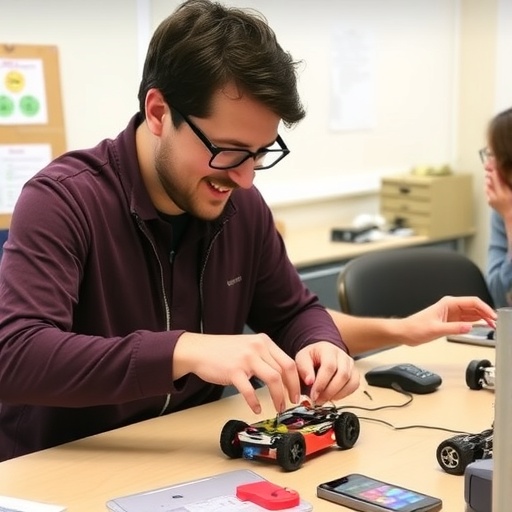
In recent years, the field of biomedical engineering has gained unprecedented momentum, especially within the context of education. The incorporation of hands-on device-based activities in educational programs has emerged as a vital approach to enhance learning outcomes. A recent study conducted by Vweza, Mehta, and Wettergreen sheds light on the transformative power of practical activities in human factors engineering, particularly in Sub-Saharan Africa. This region, with its unique challenges and opportunities, serves as an intriguing backdrop for investigating innovative teaching methodologies.
The study presents a compelling case for integrating hands-on experiences into the biomedical engineering curriculum. The rationale behind such an initiative lies in the multidimensional nature of human factors and user-centered design. In an era where medical devices are becoming increasingly sophisticated, understanding how users interact with technology is crucial. The authors propose that practical device-based activities not only deepen theoretical understanding but also foster essential skills such as problem-solving, critical thinking, and collaboration.
One notable aspect of the study is its focus on context-specific challenges faced by students in Sub-Saharan Africa. The researchers emphasize that educational initiatives must be tailored to the socioeconomic and cultural realities of the region. By employing locally relevant case studies and examples, students are more likely to engage with the material, making the learning experience both meaningful and applicable. The insights gleaned from this study could inform similar educational models in other developing regions across the globe.
The authors detail the design and implementation of a hands-on activity centered on medical devices, which serves to bridge theoretical knowledge with practical application. Students are tasked with designing, prototyping, and testing a medical device, allowing them to experience the entire process from concept to execution. This immersive learning approach not only solidifies their understanding of human factors principles but also enhances their technical prowess in developing solutions tailored to real-world health challenges.
Additionally, the study investigates the impact of this hands-on activity on student engagement and motivation. By participating in a collaborative project, students find renewed enthusiasm for their studies. The social dynamics of teamwork encourage communication and cooperation, key skills vital in the biomedical field. Moreover, the sense of accomplishment derived from creating functioning prototypes fosters a deeper commitment to their education and future careers.
Vweza, Mehta, and Wettergreen also discuss the assessment methods employed to evaluate student learning outcomes. The integration of both qualitative and quantitative measures provides a comprehensive view of the effectiveness of hands-on activities in educational programs. This multifaceted approach to assessment not only highlights the academic gains made by students but also aids in refining the curriculum for future cohorts.
One critical takeaway from this study is the acknowledgment of diverse learning styles among students. The hands-on approach accommodates various modalities of learning, ensuring that all students can engage meaningfully with the material. This adaptability is essential in a field as dynamic as biomedical engineering, where innovation and flexibility are at the forefront.
Furthermore, the authors suggest that partnerships between educational institutions, industry stakeholders, and healthcare providers can amplify the impact of these educational initiatives. By collaborating with local health authorities and professionals, students can gain exposure to real-world needs and challenges, enriching their learning experience. These partnerships not only enhance curriculum relevance but also pave the way for future employment opportunities within the healthcare sector.
The implications of this research extend beyond the classroom. As countries in Sub-Saharan Africa continue to grapple with health disparities, the need for a skilled workforce equipped to address these challenges is paramount. By training students in practical, user-focused design principles, educational programs can help cultivate a new generation of biomedical engineers who are committed to improving healthcare delivery in their communities.
In conclusion, Vweza, Mehta, and Wettergreen’s work emphasizes the transformative potential of hands-on device-based activities in biomedical engineering education. Their findings advocate for an educational paradigm shift that prioritizes practical application and contextual relevance. As more institutions adopt similar methodologies, the hope is to foster an empowered workforce capable of driving innovation and change within the healthcare landscape of Sub-Saharan Africa and beyond.
The journey of integrating hands-on activities into the biomedical engineering curriculum serves as a call to action for educators and institutions around the world. By nurturing creativity, critical thinking, and problem-solving abilities, we can better prepare the next generation of engineers and innovators. In doing so, we not only enhance their educational experience but also contribute to a healthier, more equitable future for all.
The emphasis on practical experience resonates with a growing realization in education that knowledge alone is insufficient. Future biomedical engineers must be equipped with the tools and experiences that allow them to navigate complex real-world problems. The integration of hands-on activities into the educational framework is a significant step towards achieving this goal.
This research not only highlights effective teaching methodologies but also sparks important conversations about inclusivity and diversity in education. By acknowledging the unique challenges faced by students in Sub-Saharan Africa, we open the door to innovative solutions that are culturally relevant and impactful.
In summary, the study underscores the essential role of hands-on learning in shaping the future of biomedical engineering education. As institutions look for ways to innovate and adapt in a rapidly changing world, integrating practical, user-centered design activities into the curriculum may be the key to developing more skilled, engaged, and capable professionals ready to meet the healthcare challenges of tomorrow.
Subject of Research: Hands-On Device-Based Learning in Biomedical Engineering Education
Article Title: Incorporating a Hands-On Device-Based Activity in a Human Factors Biomedical Engineering Course in Sub-Saharan Africa
Article References: Vweza, A.O., Mehta, S., Wettergreen, M. et al. Incorporating a Hands-On Device-Based Activity in a Human Factors Biomedical Engineering Course in Sub-Saharan Africa. Biomed Eng Education 4, 421–428 (2024). https://doi.org/10.1007/s43683-024-00147-5
Image Credits: AI Generated
DOI: https://doi.org/10.1007/s43683-024-00147-5
Keywords: Biomedical engineering, hands-on learning, Sub-Saharan Africa, human factors, education, device-based activities, practical application, student engagement, curriculum development.
Tags: collaboration in biomedical engineeringcritical thinking in engineering curriculaculturally relevant engineering educationdevice-based learning activitiesenhancing learning outcomes in biomedical programshands-on biomedical engineering educationhuman factors engineering in Sub-Saharan AfricaInnovative Teaching Methodologies in STEMpractical skills in engineering educationproblem-solving skills in engineeringsocioeconomic challenges in educationuser-centered design in medical technology




